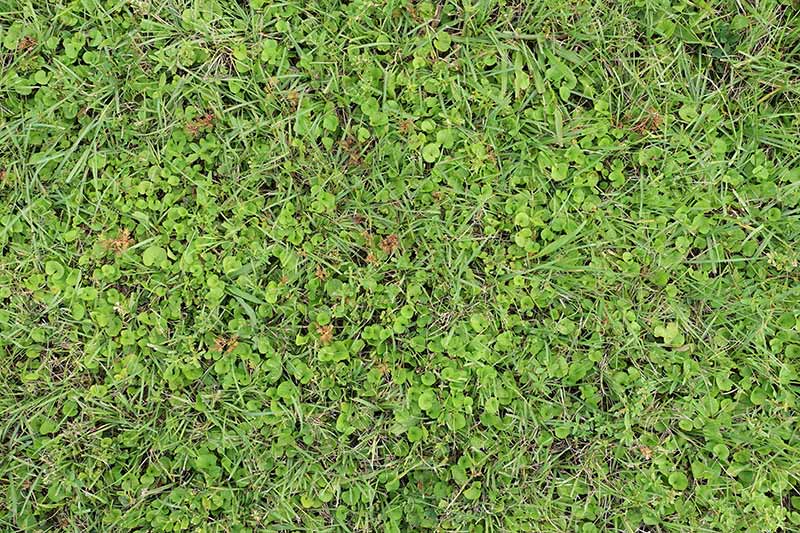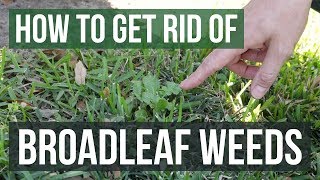To get rid of leafy weeds, regularly hand-pull them from the root, applying a layer of mulch afterward to prevent their regrowth. Leafy weeds can quickly take over your garden, competing with your desired plants for sunlight, nutrients, and water.
Dealing with these persistent intruders is essential for maintaining the health and beauty of your outdoor space. While there are various methods available, manually removing the weeds by hand is a straightforward and effective approach. By uprooting the leafy weeds at their roots, you can prevent their regrowth and minimize the need for chemical herbicides.

Credit: www.pennington.com
Adding a layer of mulch after weeding further suppresses weed growth by smothering any remaining seeds or sprouts. With these simple steps, you can take control of your garden and keep those leafy weeds at bay.
How to Get Rid of Leafy Weeds : Step by Step Guide
Understanding Leafy Weeds: A Guide To Identification And Prevention
Leafy weeds are undesired plants that can quickly invade and take over your garden or lawn. They typically have broad leaves and grow rapidly, competing with other plants for essential nutrients, water, and sunlight. These weeds can be a problem for several reasons.
What Are Leafy Weeds And Why Are They A Problem?
Leafy weeds encompass various types of plants, including dandelions, thistles, and chickweed. They spread easily through wind dispersal or by producing numerous seeds. These weeds compete with desirable plants, affecting their growth and overall health. They can also make your outdoor space appear unkempt, reducing its aesthetic appeal.
Common Types Of Leafy Weeds And Their Characteristics:
| Weed Type | Characteristics |
|---|---|
| Dandelions | Yellow flowers, deep taproots |
| Thistles | Spiky leaves, prickly stems |
| Chickweed | Tiny white flowers, small leaves |
The Impact Of Leafy Weeds On Your Garden Or Lawn:
Leafy weeds can have detrimental effects on your garden or lawn. They can steal vital nutrients from other plants, inhibiting their growth and development. Weeds also have the ability to choke out desirable plants by overshadowing them or smothering them with their dense foliage. Additionally, some weeds release chemicals that are harmful to nearby vegetation. Neglecting to address leafy weeds promptly can lead to a decline in the overall health and vibrancy of your outdoor space.
Getting To The Root: Effective Techniques For Removing Leafy Weeds
One effective technique for getting rid of leafy weeds is by manually removing them by hand. This method involves pulling the weeds out from the root, ensuring that they won’t grow back easily. It’s important to wear protective gloves while doing this to avoid any skin irritation.
Another approach to eliminating leafy weeds is by using either herbicides or organic alternatives. Herbicides can be an effective way to target and kill the weeds, but they should be used with caution and according to the manufacturer’s instructions. On the other hand, organic alternatives such as vinegar or boiling water can be used as a more environmentally-friendly option.
To effectively remove leafy weeds, it’s helpful to have the right tools and equipment. Some handy tools include a sharp pair of gardening shears or scissors for trimming and cutting weeds, a garden fork to loosen the soil around the roots, and a garden hoe for removing shallow-rooted weeds. Additionally, a garden sprayer can be useful for applying herbicides or organic weed killers.
Sustainable Weed Management Strategies For Long-term Results
Weeds can be a never-ending nuisance in any garden or yard. However, implementing cultural practices can help prevent weed growth effectively. One such practice is mulching. By covering the soil with organic materials like wood chips or straw, you create a natural weed barrier that prevents weed seeds from receiving the sunlight they need to germinate.
Another valuable cultural practice is promoting healthy soil. By enhancing the quality of your soil through organic amendments and proper watering techniques, you can help your plants develop strong root systems that outcompete weeds. Additionally, healthy soil provides an inhospitable environment for weed seeds to establish and thrive.
By incorporating these sustainable weed management strategies into your gardening routine, you can effectively get rid of leafy weeds and enjoy a weed-free landscape in the long term.
Creating A Weed-free Environment: Maintaining A Leafy Weed-free Landscape
Creating a weed-free environment requires regular maintenance routines to keep leafy weeds under control. Proper watering and fertilization techniques contribute to creating unfavorable conditions for weed growth. Watering deeply and infrequently encourages deep root growth in desired plants while depriving weeds of the moisture they need to thrive. Applying fertilizer at the appropriate times and rates helps strengthen the desired plants, making them more resilient against weed competition.
Lawn renovation and overseeding can also help prevent weed infestations. Revitalizing the lawn by removing patches of bare soil and overseeding with quality grass seeds helps to fill in any gaps, leaving little room for weeds to take hold.
Regularly mowing the lawn at the recommended height, removing any weeds that do appear, and practicing good lawn care habits such as aerating and dethatching can further discourage leafy weed growth.
By implementing these maintenance practices consistently, homeowners can create a weed-free landscape and enjoy a lush and healthy outdoor space.
Collaborating With Nature: Natural Ways To Suppress Leafy Weeds
Companion planting is an effective strategy to naturally suppress leafy weeds. By planting certain plants together, you can create a beneficial synergy that helps to deter unwanted weeds. For example, planting marigolds alongside your vegetable patch can help repel leafy weeds thanks to their strong scent. Similarly, interplanting crops such as tomatoes, peppers, or onions can create a dense canopy that shades out weed growth. Combining different plants that have natural pest-repellent properties, like garlic or basil, can also help deter leafy weeds.
Another natural approach to weed control is by incorporating beneficial insects into your garden ecosystem. Ladybugs, lacewings, and ground beetles are examples of insects that feed on various types of leafy weeds. Introducing these beneficial insects into your garden will help combat weed growth without the need for harmful chemicals. Providing them with suitable habitats and food sources, such as a diverse range of plants and permanent cover, can encourage their presence in your garden and keep leafy weeds in check.
Implementing Integrated Pest Management (IPM) practices can be an effective long-term strategy for sustainable weed control. IPM combines various methods, such as cultural practices, biological control, and minimal pesticide use, to manage pests and weeds. By focusing on prevention and monitoring, you can identify potential weed issues early on and take appropriate action. This may include regular weeding, mulching to suppress weed growth, practicing proper crop rotation, and promoting soil health through organic matter amendment. With an integrated approach, you can reduce reliance on chemical weed control and foster a healthier and more sustainable garden environment.
Wrap Up: Your Guide To A Weed-free Outdoor Space
Consistent and proactive weed management is key to maintaining a beautiful, weed-free outdoor space. To effectively get rid of leafy weeds, consider the following techniques:
| Technique | Description |
| Hand Pulling | Remove leafy weeds manually, ensuring you pull out the entire root system. |
| Mulching | Apply a layer of mulch around plants to suppress weed growth and retain moisture. |
| Herbicide Use | Select an appropriate herbicide for leafy weeds and carefully follow the instructions for application. |
| Regular Mowing | Maintain a regular mowing schedule to prevent leafy weeds from spreading and setting seeds. |
| Cultural Practices | Encourage a healthy lawn and garden by practicing proper watering, fertilizing, and aerating. |
| Professional Help | If leafy weeds persist, seek assistance from a professional landscaper or gardening service. |
Maintaining a weed-free landscape requires dedicated effort and attention. By implementing these techniques, you can successfully eliminate leafy weeds and enjoy a beautiful outdoor space.
Frequently Asked Questions On How To Get Rid Of Leafy Weeds
What Kills Broad Leaf Weeds?
Selective herbicides kill broadleaf weeds effectively without harming desirable plants. These herbicides specifically target and eliminate broadleaf weeds without causing harm to other vegetation.
What Is The Best Treatment For Broadleaf Weeds In The Lawn?
The best treatment for broadleaf weeds in the lawn is to apply a selective herbicide specifically formulated to target these types of weeds. It is important to follow the instructions provided by the manufacturer and apply the herbicide when the weeds are actively growing for the best results.
How Do I Get Rid Of Broad Leaf Grass In My Lawn?
To remove broadleaf grass from your lawn, follow these steps: 1. Identify the broadleaf grass. 2. Use a selective herbicide specifically designed to kill broadleaf grass. 3. Apply the herbicide according to the instructions on the packaging. 4. Allow time for the herbicide to take effect.
5. Regularly mow and maintain your lawn to prevent the broadleaf grass from returning.
How Do You Get Rid Of Broadleaf Plantains Naturally?
To naturally get rid of broadleaf plantains, use organic methods like hand pulling, using a weeding tool, or applying vinegar or boiling water to kill them. Regularly mow your lawn to discourage their growth and promote a healthy turf.
Conclusion
Effectively getting rid of leafy weeds requires a combination of proper identification, regular maintenance, and targeted treatments. By understanding the characteristics of different leafy weeds, implementing preventive measures, and utilizing appropriate removal methods, you can regain control of your garden and enjoy a weed-free space.
Remember to stay proactive and consistent in your approach to ensure long-term success. Happy gardening!

